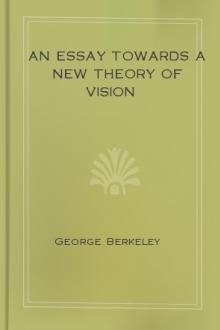An Essay Towards a New Theory of Vision by George Berkeley (the little red hen ebook txt) 📖

- Author: George Berkeley
- Performer: -
Book online «An Essay Towards a New Theory of Vision by George Berkeley (the little red hen ebook txt) 📖». Author George Berkeley
97. Afterwards, when upon turning his head or eyes up and down to the right and left he shall observe the visible objects to change, and shall also attain to know that they are called by the same names, and connected with the objects perceived by touch; then indeed he will come to speak of them and their situation, in the same terms that he has been used to apply to tangible things; and those that he perceives by turning up his eyes he will call upper, and those that by turning down his eyes he will call lower.
98. And this seems to me the true reason why he should think those objects uppermost that are painted on the lower part of his eye: for by turning the eye up they shall be distinctly seen; as likewise those that are painted on the highest part of the eye shall be distinctly seen by turning the eye down, and are for that reason esteemed lowest; for we have shown that to the immediate objects of sight considered in themselves, he would not attribute the terms HIGH and LOW. It must therefore be on account of some circumstances which are observed to attend them: and these, it is plain, are the actions of turning the eye up and down, which suggest a very obvious reason why the mind should denominate the objects of sight accordingly high or low. And without this motion of the eye, this turning it up and down in order to discern different objects, doubtless ERECT, INVERSE, and other the like terms relating to the position of tangible objects, would never have been transferred, or in any degree apprehended to belong to the ideas of sight: the mere act of seeing including nothing in it to that purpose; whereas the different situations of the eye naturally direct the mind to make a suitable judgment of the situation of objects intromitted by it.
99. Farther, when he has by experience learned the connexion there is between the several ideas of sight and touch, he will be able, by the perception he has of the situation of visible things in respect of one another, to make a sudden and true estimate of the situation of outward, tangible things corresponding to them. And thus it is he shall perceive by sight the situation of external objects which do not properly fall under that sense.
100. I know we are very prone to think that, if just made to see, we should judge of the situation of visible things as we do now: but we are also as prone to think that, at first sight, we should in the same way apprehend the distance and magnitude of objects as we do now: which hath been shown to be a false and groundless persuasion. And for the like reasons the same censure may be passed on the positive assurance that most men, before they have thought sufficiently of the matter, might have of their being able to determine by the eye at first view, whether objects were erect or inverse.
101. It will, perhaps, be objected co our opinion that a man, for instance, being thought erect when his feet are next the earth, and inverted when his head is next the earth, it doth hence follow that by the mere act of vision, without any experience or altering the situation of the eye, we should have determined whether he were erect or inverted: for both the earth itself, and the limbs of the man who stands thereon, being equally perceived by sight, one cannot choose seeing what part of the man is nearest the earth, and what part farthest from it, i.e.
whether he be erect or inverted.
I02. To which I answer, the ideas which constitute the tangible earth and man are entirely different from those which constitute the visible earth and man. Nor was it possible, by virtue of the visive faculty alone, without superadding any experience of touch, or altering the position of the eye, ever to have known, or so much as suspected, there had been any relation or connexion between them. Hence a man at first view would not denominate anything he saw earth, or head, or foot; and consequently he could not tell by the mere act of vision whether the head or feet were nearest the earth: nor, indeed, would we have thereby any thought of earth or man, erect or inverse, at all: which will be made yet more evident if we nicely observe, and make a particular comparison between, the ideas of both senses.
103. That which I see is only variety of light and colours. That which I feel is hard or soft, hot or cold, rough or smooth. What similitude, what connexion have those ideas with these? Or how is it possible that anyone should see reason to give one and the same name to combinations of ideas so very different before he had experienced their coexistence? We do not find there is any necessary connexion betwixt this or that tangible quality and any colour whatsoever. And we may sometimes perceive colours where there is nothing to be felt. All which doth make it manifest that no man, at first receiving of his sight, would know there was any agreement between this or that particular object of his sight and any object of touch he had been already acquainted with: the colours, therefore, of the head would to him no more suggest the idea of head than they would the idea of foot.
104. Farther, we have at large shown (VID. sect. 63 and 64) there is no discoverable necessary connexion between any given visible magnitude and any one particular tangible magnitude; but that it is entirely the result of custom and experience, and depends on foreign and accidental circumstances that we can by the perception of visible extension inform ourselves what may be the extension of any tangible object connected with it. Hence it is certain that neither the visible magnitude of head or foot would bring along with them into the mind, at first opening of the eyes, the respective tangible magnitudes of those parts.
105. By the foregoing section it is plain the visible figure of any part of the body hath no necessary connexion with the tangible figure thereof, so as at first sight to suggest it to the mind. For figure is the termination of magnitude; whence it follows that no visible magnitude having in its own nature an aptness to suggest any one particular tangible magnitude, so neither can any visible figure be inseparably connected with its corresponding tangible figure: so as of itself and in a way prior to experience, it might suggest it to the understanding. This will be farther evident if we consider that what seems smooth and round to the touch may to sight, if viewed through a microscope, seem quite otherwise.
106. From all which laid together and duly considered, we may clearly deduce this inference. In the first act of vision no idea entering by the eye would have a perceivable connexion with the ideas to which the names EARTH, MAN, HEAD, FOOT, etc., were annexed in the understanding of a person blind from his birth; so as in any sort to introduce them into his mind, or make themselves be called by the same names, and reputed the same things with them, as afterwards they come to be.
107. There doth, nevertheless, remain one difficulty, which perhaps may seem to press hard on our opinion, and deserve not to be passed over: for though it be granted that neither the colour, size, nor figure of the visible feet have any necessary connexion with the ideas that compose the tangible feet, so as to bring them at first sight into my mind, or make me in danger of confounding them before I had been used to, and for some time experienced their connexion: yet thus much seems undeniable, namely, that the number of the visible feet being the same with that of the tangible feet, I may from hence without any experience of sight reasonably conclude that they represent or are connected with the feet rather than the head. I say, it seems the idea of two visible feet will sooner suggest to the mind the idea of two tangible feet than of one head; so that the blind man upon first reception of the visive faculty might know which were the feet or two, and which the head or one.
108. In order to get clear of this seeming difficulty we need only observe that diversity of visible objects doth not necessarily infer diversity of tangible objects corresponding to them. A picture painted with great variety of colours affects the touch in one uniform manner; it is therefore evident that I do not by any necessary consecution, independent of experience, judge of the number of things tangible from the number of things visible. I should not, therefore, at first opening my eyes conclude that because I see two I shall feel two. How, therefore, can I, before experience teaches me, know that the visible legs, because two, are connected with the tangible legs, or the visible head, because one, is connected with the tangible head? The truth is, the things I see are so very different and heterogeneous from the things I feel that the perception of the one would never have suggested the other to my thoughts, or enabled me to pass the least judgment thereon, until I had experienced their connexion.
109. But for a fuller illustration of this matter it ought to be considered that number (however some may reckon it amongst the primary qualities) is nothing fixed and settled, really existing in things themselves. It is entirely the creature of the mind, considering either an idea by itself, or any combination of ideas to which it gives one name, and so makes it pass for an unit. According as the mind variously combines its ideas the unit varies: and as the unit, so the number, which is only a collection of units, doth also vary. We call a window one, a chimney one, and yet a house in which there are many windows and many chimneys hath an equal right to be called one, and many houses go to the making of the city. In these and the like, instances it is evident the unit constantly relates to the particular draughts the mind makes of its ideas, to which it
 A very interesting statement of one of our contemporaries is that any person, to one degree or another, is both a psychologist and a philosopher - they say, life forces him to. On the one hand, the main driving force of every person is the craving for knowledge, the desire to reach certain social heights, the desire to be wise in any everyday situations - and this is the philosophy of life.
A very interesting statement of one of our contemporaries is that any person, to one degree or another, is both a psychologist and a philosopher - they say, life forces him to. On the one hand, the main driving force of every person is the craving for knowledge, the desire to reach certain social heights, the desire to be wise in any everyday situations - and this is the philosophy of life. 




Comments (0)